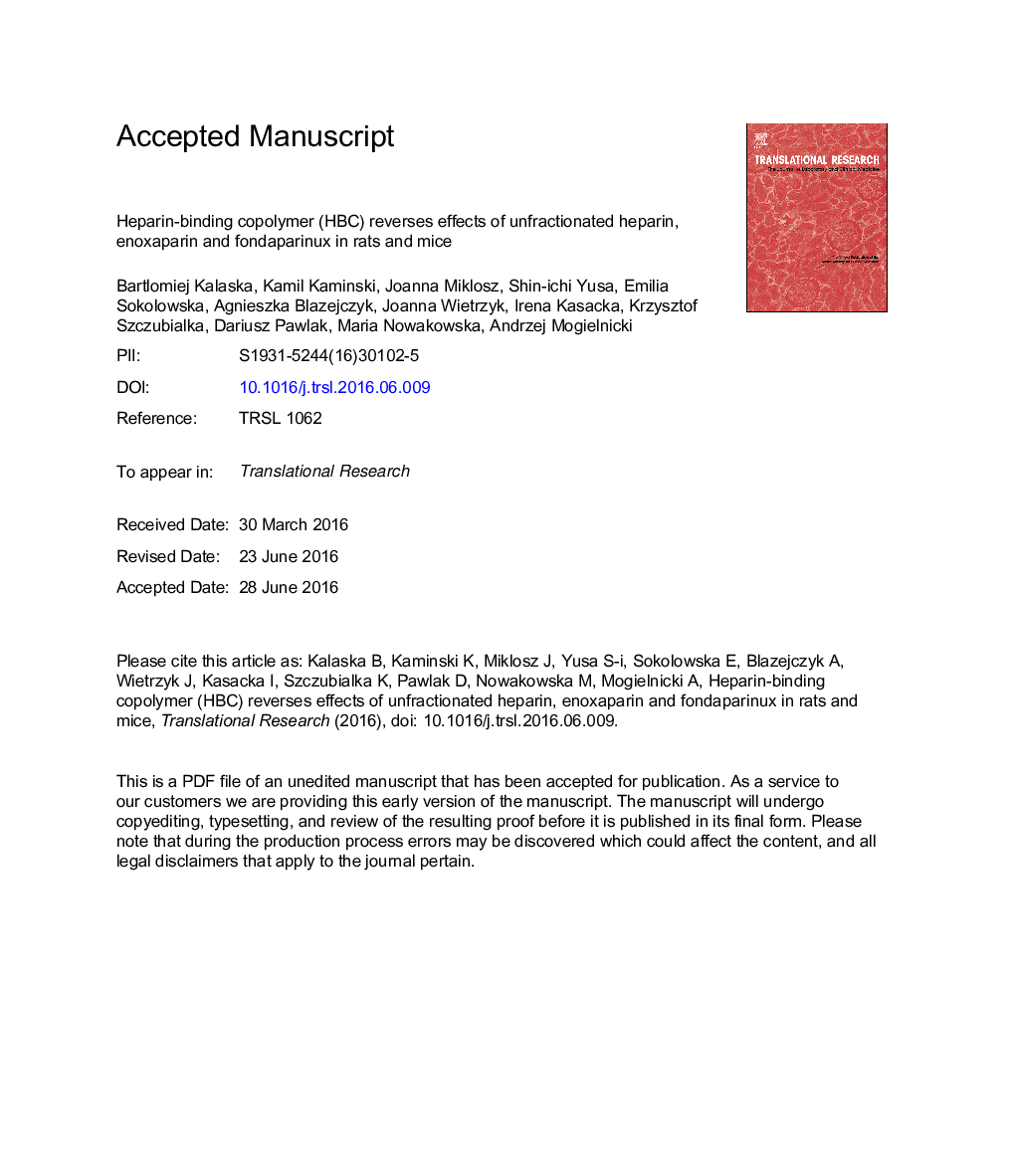| Article ID | Journal | Published Year | Pages | File Type |
|---|---|---|---|---|
| 5685136 | Translational Research | 2016 | 56 Pages |
Abstract
The parenteral anticoagulants may cause uncontrolled and life-threatening bleeding. Protamine, the only registered heparin antidote, is partially effective against low-molecular weight heparins, completely ineffective against fondaparinux and may cause unacceptable toxicity. Therefore, we aimed to develop a synthetic compound for safe and efficient neutralization of all parenteral anticoagulants. We synthesized pegylated PMAPTAC block copolymers, and then, we selected a lead heparin-binding copolymer (HBC). We assessed the effectiveness of HBC in the model of arterial thrombosis electrically induced in the carotid artery of rats by measuring thrombus weight, bleeding time, activated partial thromboplastin time, activated clotting time, and anti-factor Xa activity. The intravital tissue distribution, the cardiorespiratory, and organ toxicity were monitored. HBC diminished antithrombotic and anticoagulant effects of unfractionated heparin. Moreover, it stopped bleeding and completely reversed the enhancement of clotting times and anti-factor Xa activity caused by enoxaparin or fondaparinux. We observed slight pulmonary congestion and cell infiltration, but the cardiorespiratory parameters remained unchanged. We found a strong signal of fluorescently-labeled HBC in the urine, and a weaker in the liver and in the kidney. No signs of hepatic or nephrotoxicity were observed in the blood biochemistry or histopathologic examination. We developed a copolymer efficiently neutralizing effects of heparins in the living organism, which shows a very promising efficacy/safety profile and may help in the management of uncontrolled bleeding resulting from an anticoagulant injection. HBC could enable the safe replacement of unfractionated heparin with low-molecular weight heparins in patients undergoing cardiac surgery and complex vascular procedures.
Keywords
CPKMCHPLTLMWHGPCUFHALTRBCHCTCREAACTMCHCWBCPBSMBPMAPTACAPTTMCVMPCHBCFBSnuclear magnetic resonanceRed blood cellsASTAspartate aminotransferasealanine transaminaseALPAlkaline phosphataseNMRMean corpuscular volumeMinimum Essential Medium Eagledegree of polymerizationactivated partial thromboplastin timeactivated clotting timefetal bovine serumPhosphate buffered salinemean blood pressureMEMmean corpuscular hemoglobinMean corpuscular hemoglobin concentrationhematocritHemoglobinHgbunfractionated heparinBlood plateletsPEGCreatine phosphokinasecreatinineGel permeation chromatographywhite blood cells
Related Topics
Health Sciences
Medicine and Dentistry
Medicine and Dentistry (General)
Authors
Bartlomiej Kalaska, Kamil Kaminski, Joanna Miklosz, Shin-ichi Yusa, Emilia Sokolowska, Agnieszka Blazejczyk, Joanna Wietrzyk, Irena Kasacka, Krzysztof Szczubialka, Dariusz Pawlak, Maria Nowakowska, Andrzej Mogielnicki,
